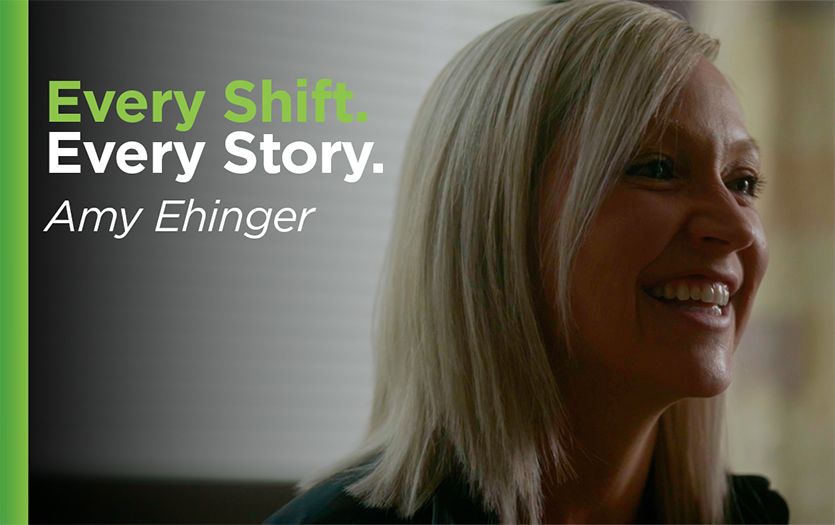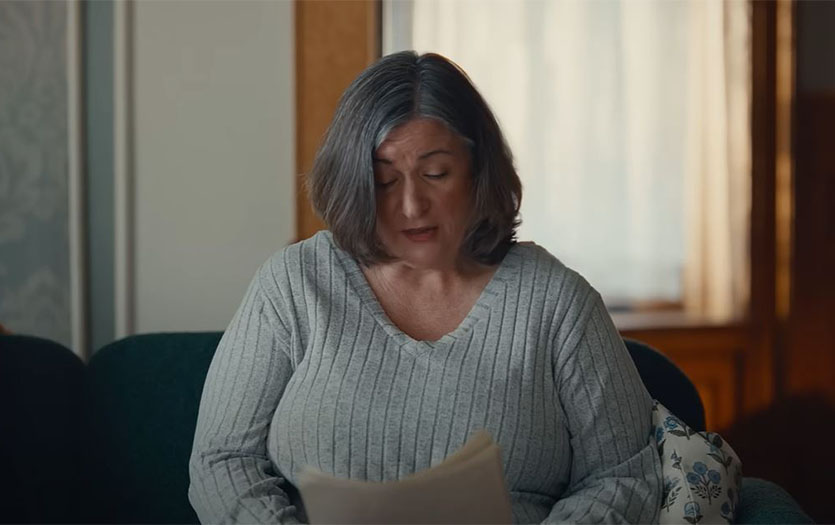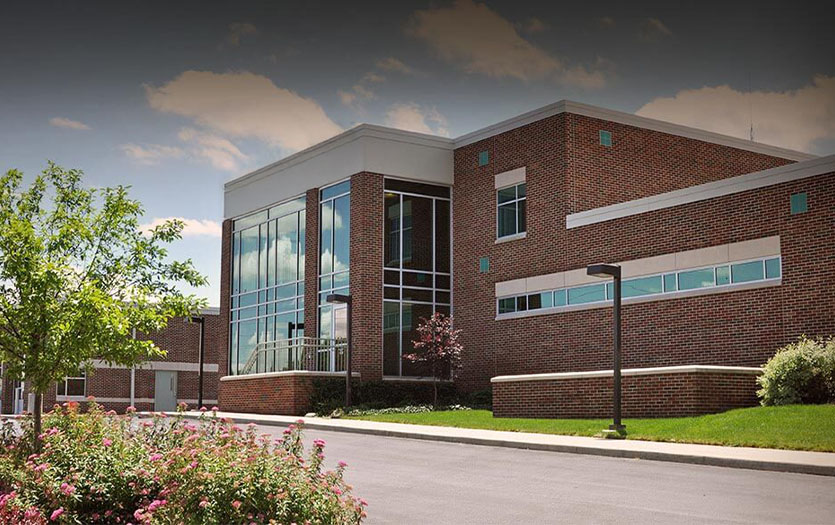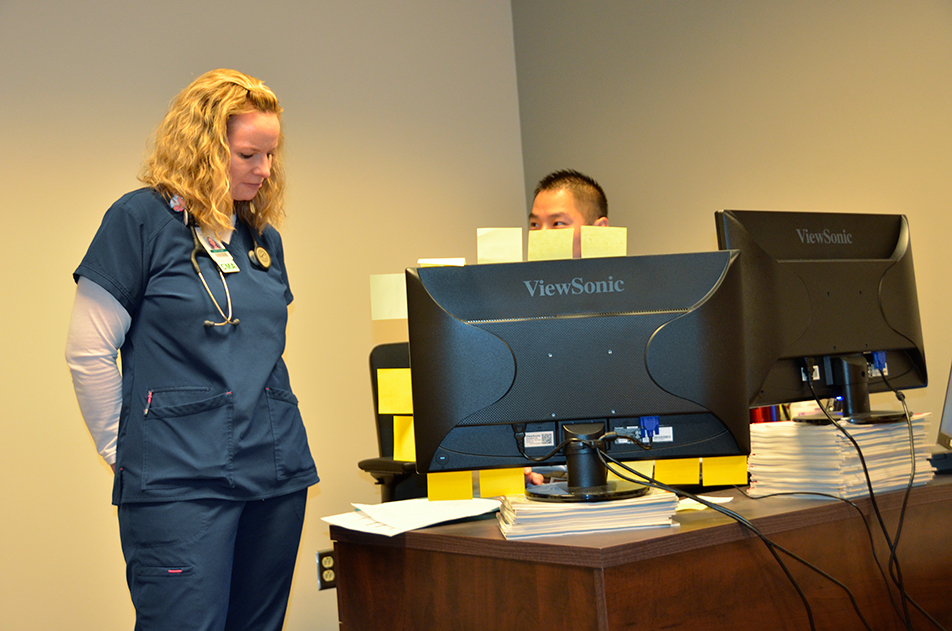
This post was written by Courtney Leach, digital/social media manager.
Sleep. It is simultaneously the most abundant and underutilized pathway to health and restoration. It ranks among the world’s most powerful of medications and effective counselors. It is, undoubtedly, a respite and a healer. So often, the resolve for the things that ail us is waiting just beyond our dreams, if we can only make that time and space a priority.
Conversely, indications that we are lacking in sleep, feelings of drowsiness and depression, can be warning shots fired across our body’s bow to caution us of bigger health concerns. I knew long before I decided to spend a day observing Aaron Roberts, MD, PPG – Sleep Medicine, that our country was in a sleep crisis. But in an effort to arm myself with the facts, I looked up the latest statistics.
Analytics compiled by the American Sleep Association® paint a pretty bleak picture:
- 50-70 million U.S. adults have a sleep disorder
- 48 percent report snoring while 37.9 percent report unintentionally falling asleep
- Insomnia is the most common specific sleep disorder, with short term issues reported by about 30 percent of adults and chronic insomnia by 10 percent
- 25 million U.S. adults have obstructive sleep apnea (9-21 percent of women and 4-31 percent of men)
- Incidence of narcolepsy effect 50 per 100,000 people
- 35.3 percent of adults report getting less than 7 hours of sleep during a typical 24-hour period, despite the fact that the recommendation is 7-9 hours minimum for adults.
Despite the fact that we know we need sleep to function, most Americans struggle with making it a priority until there are signs of trouble. And, based on Dr. Roberts’ workload on the day I shadowed him, there is an abundance of trouble.
On this particular Monday, he was working at the team’s office in the lower level of Parkview Hospital Randallia, at Entrance 4. Dr. Roberts, along with Dr. Srinivasan Devanathan and Dr. Ram Verma, rotate between this Sleep Medicine clinic, the one at Woodland Plaza and the community hospital clinics. They come together once a week to touch base and discuss their cases.

With 14 patients – a mix of new and follow-up – on the schedule, it didn’t take long for the first appointment to arrive. This would be the first in a string of sleep apnea cases. During these visits, of which there are many, Dr. Roberts’ goal is to make sure the patient has everything they need to be compliant and comfortable, and make sure the treatment is correcting the issue.
Sleep apnea is a common sleep disorder in which the person repeatedly stops breathing throughout sleep. The most common form, obstructive sleep apnea, occurs when throat muscles intermittently relax during sleep, which can block the airway. According to Dr. Roberts, most people who have this condition will go years without knowing, until a bed partner complains of their restlessness or tendency to snore.
When diagnosing sleep apnea, the physician looks at how many times the person stops breathing in an hour. For a child, less than 1.5 times is considered normal, 1.5-5 times is considered mild sleep apnea, 5-10 times is considered moderate and anything above 10 is considered severe sleep apnea. For adults, the numbers are a bit higher: less than 5 times is normal, 5-15 is mild, 15-30 is moderate and anything above 30 is considered severe sleep apnea.
I asked Dr. Roberts why we are seeing so many more cases of this condition. “It’s likely that sleep disorders like this have always been around but now people are more aware,” he said. “Also, with sleep apnea, age and obesity are two of the biggest contributors, so it’s hard not to know someone who is dealing with it.” Diagnosing the condition has also become much more convenient, with the addition of home sleep studies.
“Sleep apnea puts an incredible strain on the heart and lungs,” Dr. Roberts said. “It’s the equivalent of someone choking you until you turn blue and then letting you go. Your oxygen can get down into the 60s on a nightly basis.” (A healthy oxygen range is 90-100 percent.)
The gold standard treatment for sleep apnea is continuous positive airway pressure (CPAP) therapy. This involves a machine with a hose and mask or nosepiece that delivers constant and steady air pressure to the patient, thus preventing the interruption to their breathing. Prior to a sleep apnea patient’s arrival, Dr. Roberts medical assistant, Jenny Doctor, will pull data from the patient’s CPAP machine, which provides the feedback he needs to determine how consistent the patient is being and how effective the therapy is.
Sometimes the biggest trick is finding the nosepiece and headpiece that is most comfortable for the individual, as was the case with his first patient of the day. Clearly the therapy was working. The output from his machine showed a dramatic improvement to his breathing, but the fit just wasn’t what he wanted it to be. Dr. Roberts asked a series of questions, pulled up different models online and offered a few samples for the patient to try. Like most things in life, if it’s comfortable, the tendency to comply is much higher, so it’s important that they find an option that will work.
Back in his office, I asked Dr. Roberts what brought him to sleep medicine, a profession he’s enjoyed at Parkview for more than three years now. “I went to medical school at Indiana University and did my residency at Michigan State – Kalamazoo. During my residency, someone came in and spoke with us about sleep medicine, so I decided to try it and I really liked it. It’s very interesting. I like the idea that I can make a big difference in the quality of a person’s life. So, I went back to IU for my sleep medicine fellowship.” Helping others is a family affair. Dr. Roberts’ wife, Rachel, is a mental health counselor, and the two often discuss the role of sleep in a person’s overall well-being and how conditions like insomnia are often linked to anxiety, stress or other emotional issues. Her perspective is a welcome tool in his arsenal of tactics.
As the next patient comes in, Jenny takes them into the room to get their oxygen and conduct the Epworth Sleepiness Scale (ESS) – a test in which she presents a series of scenarios and has the individual rate, on a scale of 0-3, how likely they are to doze off. This feedback can indicate increased daytime sleepiness, a singing canary for multiple sleep disorders.
While most of us believe something as serious as a sleep disorder must present with bold, dramatic symptoms, that’s not necessarily the case. Vivid dreams, grogginess, an inability to concentrate, mood problems or the feeling you’re never getting enough sleep can all be subtle signs of a sleep disorder. By far, the most common is sleep apnea, followed by insomnia and then restless legs.
The second patient of the day was dealing with one of Dr. Roberts specialties, narcolepsy. While the media paints a picture of people instantly falling into unpredictable sleep patterns as a result of this condition – their head dropping loudly onto a desk during an important meeting, for example – Dr. Roberts explained it’s a bit subtler than its reputation might have us believe.
“Narcolepsy is really underdiagnosed,” he said, “In fact, it typically takes around 10 years for a person to receive the diagnosis. This is because people with narcolepsy just feel a general sense of fatigue. They often experience depression and mood changes as well. What’s happening is there’s no regulation of the sleep/wake cycle. Their bodies want to get a few hours of sleep here, a few hours of sleep there, and they aren’t getting that good, quality, consistent block of rest, no matter how much they sleep. They typically visit a range of specialties to address the fatigue and other subtle symptoms before seeking help from a sleep medicine physician.”
While there is no cure for narcolepsy, there are pharmaceuticals that can help manage the condition. “We offer medications that will keep the person awake during the day so they can function and also consolidate their sleep at night. Once we get the right prescriptions, these patients see a dramatic improvement to their quality of life. Good sleep can improve kidney function, heart rate, blood pressure, and on and on.” The trick is finding the right combination. For people with careers and children and busy lives, the balance between alert and asleep is essential, and nuanced. Dr. Roberts listens to what’s working and what isn’t and makes modifications to accommodate the patient’s lifestyle.
Between appointments, I asked Dr. Roberts about dreams and what they’re really telling us. “They are actually a common sign that you are waking during the REM cycle of sleep. When someone tells me they’re having a lot of vivid dream, I’m often thinking of sleep apnea and narcolepsy, as these are both conditions where the patient wakes up a lot. Dreams alone are never the problem. They are a sign of something bigger.”
A team member from the Sleep Lab walked into his office and handed Dr. Roberts a generous stack of sleep studies to review. If a sleep study, either in home or in the Sleep Lab, is ordered for any patient, Dr. Roberts or one of the other sleep medicine physicians has to review the results and sign the report. On a typical day, Dr. Roberts will review around 10 sleep studies, with each taking approximately 20 minutes to analyze, offer notes and supply recommendations. In addition to these results, the sleep medicine physicians have to sign off on all certificates of medical necessity (CMNs) for CPAP machines. It’s a lot of paperwork, to say the least. Add to that the incoming MyChart messages from existing patients and you have a packed day. One thing Dr. Roberts prides himself on is his commitment to staying “caught up” and on top of things. Some days this comes easier than others.
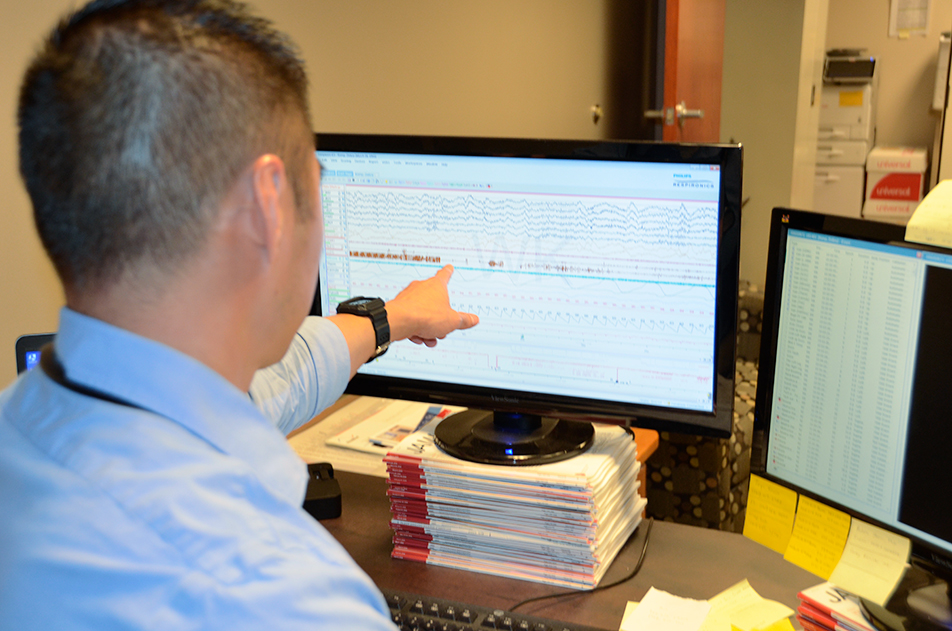
I looked at a sleep study over his shoulder. To my nonclinical eye, it was just a series of scribbles and bars on a screen. He pointed to a clump of spikes. “This indicates arousal,” he explained. A solid horizontal bar represented how long the subject was not breathing. When this happens, the individual’s oxygen drops. This particular person quit breathing 52 times in one hour. When I expressed my shock, Dr. Roberts said, “I’ve seen some as high as 180 times in an hour.”
The next appointment was a new patient, which is incredibly common in the sleep medicine clinics since the physicians work so closely with a number of other specialties in the health system. While a fair amount of referrals come in from primary care physicians, there’s also quite a bit from cardiology, psychiatry, integrative medicine, ENT and weight management, just to name a few. “Cardiology is probably the most common,” Dr. Roberts said, “because sleep apnea is linked to an increased risk of heart attack, AFib and high blood pressure.”
Overall, sleep disorders increase the risk of hospitalization for events like stroke, dementia and cardiovascular issues, and more and more, doctors are making the connection and sending patients to Sleep Medicine. “For years I think sleep was neglected,” he said. “Now it’s getting the respect it deserves in regard to our health.”
New patient appointments are typically around 40 minutes. It takes this long for Dr. Roberts to obtain a thorough background. He wants to know about the patient’s medical history, sleep habits, napping habits, overall health habits and their general routine.
Dr. Roberts also sees children. He is the only physician in the Sleep Medicine practice with a background in Pediatrics. “I had a range of interests and I knew I wanted to see a lot of different cases, so I did a dual residency in Internal Medicine and Pediatrics.” During his residency at IU, he spent some time working in the sleep lab at Riley Children’s Hospital. “With kids, there’s a whole different set of issues,” he said. “These cases take a big longer because I’m counseling two people – the child and the parent. It’s rarer, but their issues can be linked to sleep apnea as well. If they have narcolepsy it would set in around puberty, but again, typically isn’t diagnosed until their 20s or 30s.”
The majority of issues for those under 18 can be linked to anatomy or sleep hygiene. “Teens have such poor sleep practices. They stay up too late on screens and social media.” With younger kids, it can be a matter of the family routine. “We see a lot of co-sleeping,” Dr. Roberts said. “Parents will rock the child or let them into their bed and this can lead to sleep issues down the road. Little kids are also getting so much more screen time. They’ll fall asleep with a tablet and the blue light can really disrupt their natural melatonin production and interrupt sleep. Little ones should be on screens for a maximum of one hour a day, and ideally, all screen time would end 30-60 minutes before bed.”
Sleep apnea is very different in kids. “Often their adenoids and tonsils need to be removed to address the sleep issue, since big tonsils and adenoids can block the airway. They’ll go to an ENT and if the sleep study is positive, that’s the course of treatment.” For children, sleep studies have to happen in the Sleep Lab, and parents are welcome to stay with their child. They are looking at everything from head to toe, including breathing patterns, leg movements, heart rate and oxygen levels. “Nearly 80 percent of the time removing the adenoids and tonsils is the cure. They don’t even require any follow up.”
Children have a higher tendency for night terrors, sleepwalking and talking in their sleep, but often grow out of these disorders by age 10. “It’s dangerous, because it’s been shown that these patients don’t feel pain. So they’ll walk outside in winter without shoes on and won’t feel a thing. That pain mechanism has been shut off.”
It’s also very common for the sleep medicine doctors to see family members – husbands and wives, parents and children, etc. Dr. Roberts explained that this is because the patient is either thinking of the other person’s sleep health and it reminds them of their own or the other person’s sleep is affecting their sleep.
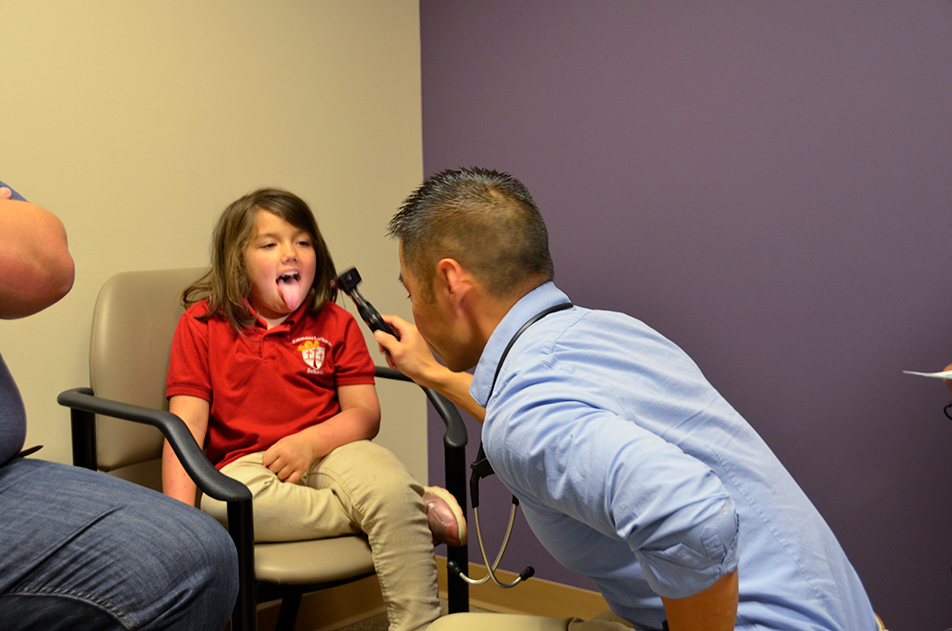
The next pair of new patients was a father and daughter. The parents had been receiving reports back from the school that their little girl was awfully sleepy during class. As an observer, I realized how tricky discussing sleep with a six-year-old could be. Children are often shy and unsure, and so the physician has to rely heavily on information and observances from the parents. This was just one of the additional complexities related to pediatric cases.
Her dad had received a CPAP machine years ago, when he lived in another state, and hadn’t had any follow up since. Dr. Roberts asked his list of questions. “Do you use an alarm clock to wake up? Do you nap? Do you grind your teeth in your sleep? What do you do before you go to bed? Do you read or watch TV?”
One after another after another, I watched him ask these questions. While the faces changed, the risk factors for sleep apnea stayed the same. “Are you over 50? Is your BMI greater than 35? Are you male? Does your bed partner complain of you snoring? Do you feel fatigued? Do you have high blood pressure?” And case after case, I listened as Dr. Roberts said, “If a person has at least three of these risk factors they are considered high risk. You have three,” or “You have four,” or “You have five.” It was an exchange that took place so many times during my day with Dr. Roberts, I was beginning to memorize portions of the assessment. “People will come in and say they don’t sleep in the same room as their partner because they snore, and they think that’s normal. It’s not.”
For the patient who was seeking follow up after years of already using his machine, the results were positive. Dr. Roberts pulled the data and showed the gentleman his apnea-hypopnea index (AHI) score, which means how many times he stopped breathing in an hour while wearing the CPAP machine. He was down to less than five times, which was a significant improvement.
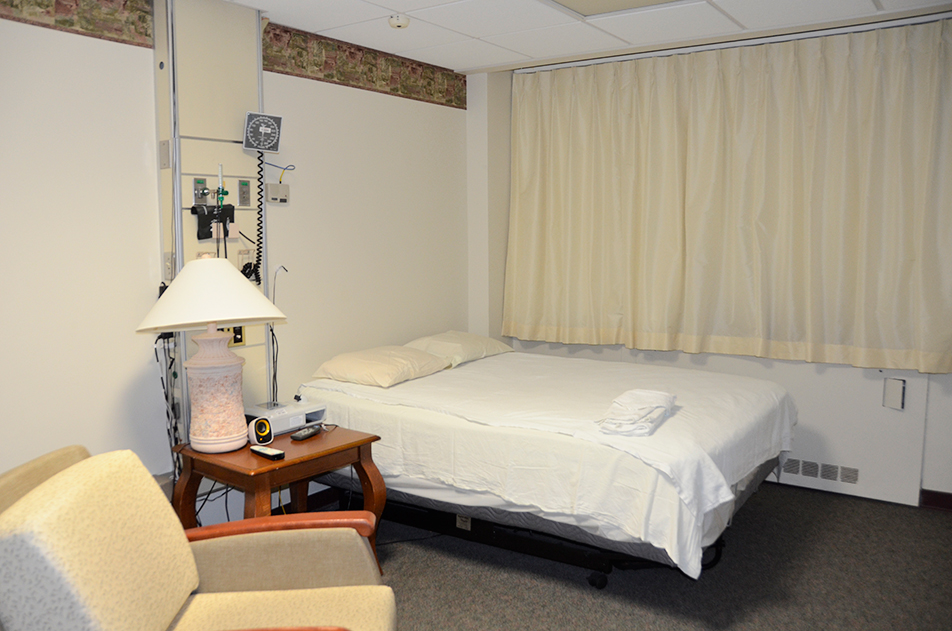
It was noon and Dr. Roberts had a routine to stick to. He took me up eight flights of stairs to the Sleep Lab, which resides in the top floor of Randallia. “This is my cardio for the day,” he said. I was breathless by the fifth floor, trying to ask questions between gasping for air. When we walked in to the Sleep Lab, I met Christy Kanis, head sleep tech. The Sleep Lab at Randallia has plans to expand to 14 rooms this summer. It currently conducts sleep studies for 6-8 patients per night. While the individual sleeps, the sleep techs score them on a range of observances and vitals and include that information in the sleep study that goes back to the physicians.
We made our way back to the lower level and swung through the physician’s lounge so Dr. Roberts could grab lunch. I sat on my laptop and listened to the second hand on the clock work its way around as he poured over sleep studies, MyChart messages and notes in patient files. He’d break the silence with a fury of key tapping, then take a bite of food, and then the silence would settle back into the space between us. Then more typing and another bite. He had just a handful of minutes before the afternoon appointments would begin.

The next case was a gentleman who came to Sleep Medicine as a means to comply with his employer and meet the criteria to keep his Commercial Driver’s License (CDL). “Are you working on the smoking, how’s that going?” Dr. Roberts asked. “Then your weight would be the next thing.” According to the physician, people need to lose 10-20 percent of their body weight from the time a sleep study is conducted in order to redo the sleep study. “And keep it off,” he added. “If they can quit smoking that’s another big advantage.”
The eleventh patient of the day was there at the insistence of his new wife, who noticed he would stop breathing and had a tendency to snore. True to what Dr. Roberts told me earlier in the day, the patient had no idea he had this problem before getting married. Dr. Roberts asked the patient about his allergies, which can also have an impact on sleep health. “Fortunately, CPAP therapy has come a long way. The machine is quiet and there are so many mask options,” he told the patient, after they’d arrived at the near certainty he had sleep apnea. Of course they’d need the sleep study to confirm.
After the final patient had come and gone, I couldn’t help but notice I was feeling tired. Fatigued, I suppose, from all the talk of sleep hygiene, napping and drowsiness.
The hope for Dr. Roberts and his colleagues, is that, just as other medical specialties have come to give sleep the respect it deserves, so, too, will the rest of us. Creating a sanctuary for sleep, free from screens and work obligations and stress is an important first step. Learning not to ignore subtle signs of restlessness is a second. You wouldn’t disregard an open wound or a racing heart. And you shouldn’t hit snooze on a sleepy soul, either. The key to a longer, healthier, happier life is resting on your pillow. You just have to make it a priority.
I powered down a few minutes earlier that night. I made my children do the same. I love my heart for beating, my lungs for breathing and my mind for fueling my thoughts and feelings. I’d learned from my day with Dr. Roberts, that turning out the lights and laying down before the final star was in the sky that night was the most genuine gesture I could give my body. When I awoke the next morning, I couldn’t remember a single dream, and for possibly the first time ever, I felt thankful.

